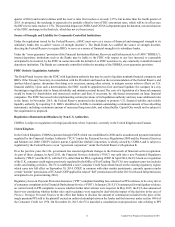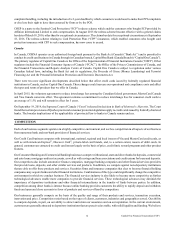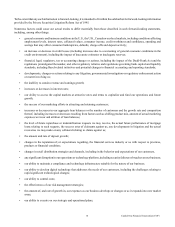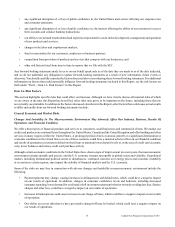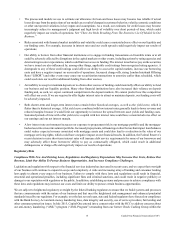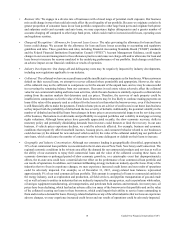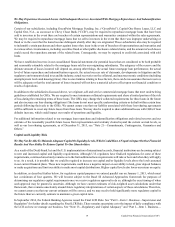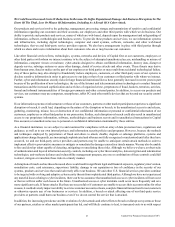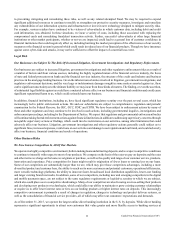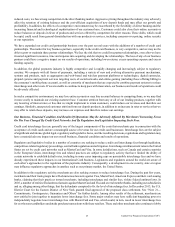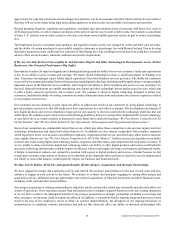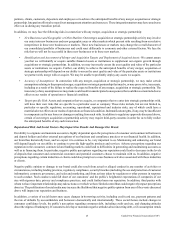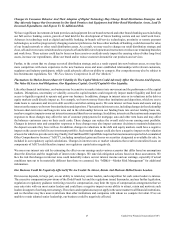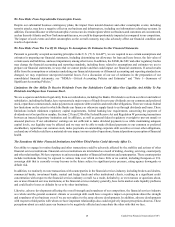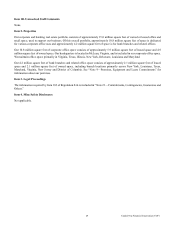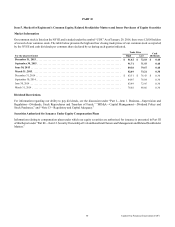Capital One 2015 Annual Report Download - page 39
Download and view the complete annual report
Please find page 39 of the 2015 Capital One annual report below. You can navigate through the pages in the report by either clicking on the pages listed below, or by using the keyword search tool below to find specific information within the annual report.20 Capital One Financial Corporation (COF)
Supervision and Regulation—Dividends, Stock Repurchases and Transfers of Funds” for additional information regarding recent
developments in capital and liquidity requirements.
We consider various factors in the management of capital, including the impact of stress on our capital levels, as determined by
both our internal modeling and the Federal Reserve’s modeling of our capital position in CCAR. In recent stress test cycles,
including CCAR, we have observed a large difference between our estimates of our capital levels under stress and the Federal
Reserve’s estimates of our capital levels under stress. In the current stress test cycle, including CCAR, the difference could be
larger because we expect the Federal Reserve to continue to use its own assumptions in modeling results. Therefore, although our
estimated capital levels under stress suggest that we have substantial capacity to return capital to shareholders and remain well
capitalized under stress, it is possible that the Federal Reserve’s modeling may result in a materially lower capacity to return capital
to shareholders than our estimates. See “Part I—Item 1. Business—Supervision and Regulation” for additional information.
Operational Risk
We Face Risks Related To Our Operational, Technological And Organizational Infrastructure.
Our ability to grow and compete is dependent on our ability to build or acquire necessary operational, technological and
organizational infrastructure or adapt to technological advances involving such infrastructure, which can be a challenge due to the
fast pace of digital transformation and advances. We are embedding technology, data, and software development deeply into our
business model and how we work.
Similar to other large corporations, we are exposed to operational risk that can manifest itself in many ways, such as errors related
to failed or inadequate processes, inaccurate models, faulty or disabled computer systems, fraud by employees or persons outside
of our company and exposure to external events. In addition, we are heavily dependent on the strength and capability of our
technology systems which we use to manage our internal financial and other systems, interface with our customers and develop
and implement effective marketing campaigns. We also depend on models to measure risks, estimate certain financial values,
determine pricing on certain products, assess capital adequacy and calculate regulatory capital levels. If we implement or design
our models poorly or use inaccurate assumptions in our models, business decisions based on the output of the models may be
adversely affected. See “There Are Risks Resulting From The Extensive Use Of Models In Our Business.”
In addition, our businesses are dependent on our ability to process, record and monitor a large number of complex transactions.
If any of our financial, accounting, or other data processing systems fail or have other significant shortcomings, our business and
reputation could be materially adversely affected. We may also be subject to disruptions of our operating systems arising from
events that are wholly or partially beyond our control, which may include, for example, computer viruses or electrical or
telecommunications outages, cyber-attacks, including Distributed Denial of Service (“DDOS”) attacks discussed below, natural
disasters, other damage to property or physical assets or events arising from local or larger scale politics, including terrorist acts.
Any of these occurrences could diminish our ability to operate our businesses, service customer accounts, and protect customers’
information, or result in potential liability to customers, reputational damage, regulatory intervention and customers’ loss of
confidence in our businesses, any of which could result in a material adverse effect. We also rely on the business infrastructure
and systems of third parties with which we do business and to whom we outsource the maintenance and development of operational
and technological functionality. System breakdowns or failures, adverse changes to financial condition, bankruptcy or other adverse
conditions affecting the businesses of such third parties, including our vendors and other service providers, could have a material
adverse effect on our business and reputation. Thus, any increase in the amount of our infrastructure that we outsource to third
parties may increase our risk exposure.
Our ability to develop and deliver new products that meet the needs of our existing customers and attract new ones and to run our
business in compliance with applicable laws and regulations depends on the functionality and reliability of our operational and
technology systems. Any disruptions, failures or inaccuracies of our operational and technology systems and models, including
those associated with improvements or modifications to such systems and models, could cause us to be unable to market and
manage our products and services, manage our risk or to report our financial results in a timely and accurate manner, all of which
could have a negative impact on our results of operations. In addition, our ongoing investments in infrastructure, which are necessary
to maintain a competitive business, integrate acquisitions and establish scalable operations, may increase our expenses. As our
business develops, changes or expands, additional expenses can arise as a result of a reevaluation of business strategies, management
of outsourced services, asset purchases or other acquisitions, structural reorganization, compliance with new laws or regulations
or the integration of newly acquired businesses. If we are unable to successfully manage our expenses, our financial results will
be negatively affected.



